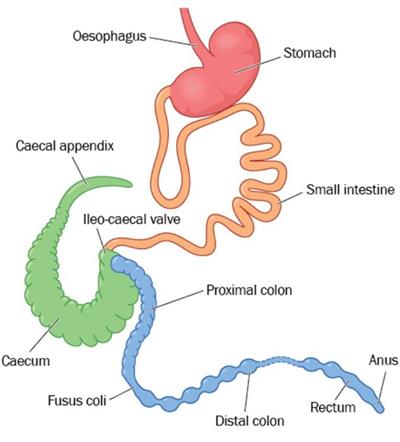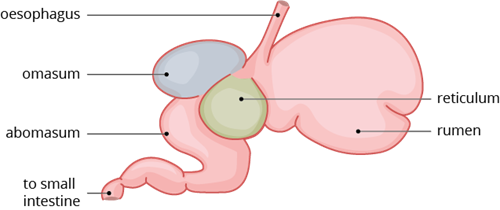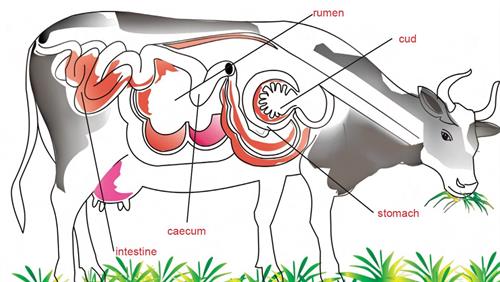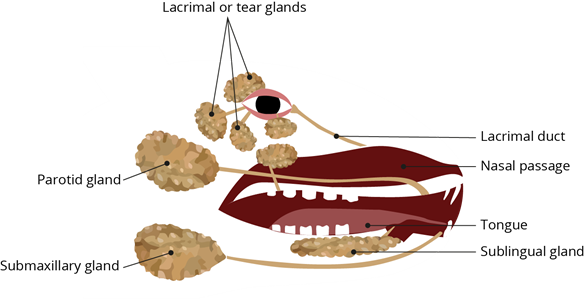
PUMPA - SMART LEARNING
எங்கள் ஆசிரியர்களுடன் 1-ஆன்-1 ஆலோசனை நேரத்தைப் பெறுங்கள். டாப்பர் ஆவதற்கு நாங்கள் பயிற்சி அளிப்போம்
Book Free DemoTo break down the complex food into simpler forms, animals need a digestive system.
Earlier in this topic, we have studied the processes of digestion. Now, we will learn about the digestive system of rabbits.

Digestive system of rabbit
Alimentary canal, starts from the mouth and ends at the anus. The mesentery keeps it suspended in the body cavity. The mouth, vestibule, buccal cavity, pharynx, oesophagus, stomach, small intestine, caecum, and large intestine make up the alimentary canal.
Flow chart of the process of digestion in the rabbit:
Mouth
\huge{\downarrow}
Vestibule
Vestibule
\huge{\downarrow}
Buccal cavity
Buccal cavity
\huge{\downarrow}
pharynx
pharynx
\huge{\downarrow}
Oesophagus
Oesophagus
\huge{\downarrow}
Stomach
Stomach
\huge{\downarrow}
Small intestine
\huge{\downarrow}
Large intestine
Large intestine
\huge{\downarrow}
Rectum
\huge{\downarrow}
Anus
Anus
Mouth:
The mouth is a transverse slit-like aperture bounded by the upper and lower lips, which are soft and muscular.
Vestibule:
The mouth opens into a narrow vertical space called the vestibule, located between the lips, cheeks, and jaw gums. Mucous secreting glands are found on its mucous membrane.
Buccal cavity:
The vestibule leads to the buccal cavity, which is large and spacious. A muscular tongue occupies the floor of the buccal cavity. Teeth are housed in the jaws. The mucous membranelines the buccal cavity.
Pharynx:
The buccal cavity indistinguishably passes posteriorly into the pharynx, which is a small and narrow cavity. The pharynx connects the buccal cavity to the oesophagus.
Oesophagus:
The oesophagus is a tube that connects the mouth to the stomach and transports food.
It is a long, narrow, distensible muscular tube that runs through the neck and thorax and can be expanded. It opens into the stomach, which is located in the abdominal cavity, after piercing the diaphragm.
Stomach:
The tube-like structure oesophagus connects the throat to the stomach. A large, curved sac-like structure is located behind the diaphragm, slightly towards the left side in the abdominal cavity is called stomach.

Structure of rabbit stomach with locating the rumen
Intestine:
The stomach leads into the intestine. The intestine of a rabbit is coiled and lengthy, measuring almost 1.2 metres in length, and can be divided into small and large intestines.
Small intestine:
The duodenum, jejunum, and ileum make up the small intestine.

Intestine with coecum and colon
Caecum:
The caecum is a thin-walled sac located at the junction of the small and large intestines. It contains bacteria that aid in cellulose digestion.
Note: The digestive tract of a rabbit is very similar to that of a horse. Both are “hind-gut fermenters,” which means they have an organ called the “caecum” that acts similarly to a cow’s rumen but is located at the end of the digestive tract rather than at the beginning.

Cow's digestive system
Large intestine:
The small intestineopens into the large intestine. The proximal colon and the distal rectum are the two parts of it.
Anus:
The rectum finally opens outside by the anus. It is located towards the tail’s base. An anal sphincter guards the anus.
Digestive glands of rabbit:
Digestive glands are glands that secrete digestive juices to aid in food digestion.
The glands associated with the digestive system include salivary glands, gastric glands, intestinal glands, the liver and the pancreas. Digestive gland secretions aid in the digestion of food in the alimentary canal.
- Salivary glands are present in our buccal cavity.
- The gastric glands are found in the mucosa's innermost layer.
- Intestinal glands are located in the epithelia of the small intestine, namely the duodenum, jejunum, and ileum, and in the large intestine.
- The liver is located in the upper part of the abdomen on the right side.
- The pancreas is a gland that is located below the stomach.

Salivary glands
Important!
The liver is the body's largest gland.